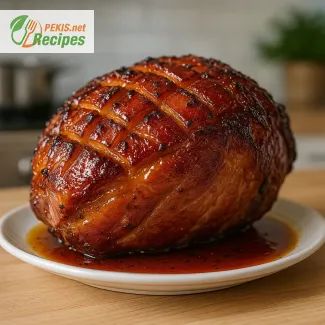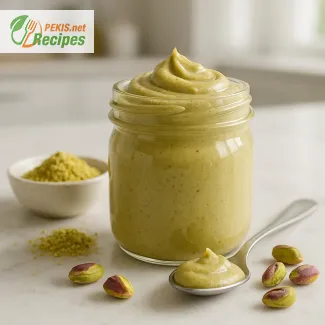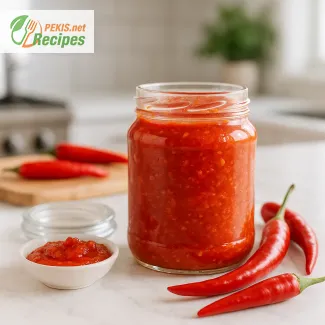
The Ultimate Ham Glaze Recipe: A Perfect Sweet and Savory Finish for Your Ham
Why This Ham Glaze is the Perfect Addition to Your Holiday Meal
A ham glaze is more than just a topping—it's a game-changer. Whether you're preparing a traditional holiday feast or just craving a sweet and savory twist on your regular ham, the right glaze can elevate the dish to new heights. This ham glaze recipe combines the best elements of both sweet and tangy flavors, creating a sticky, mouthwatering layer that coats your ham in the most irresistible way.
As the glaze caramelizes in the oven, it creates a golden-brown crust, transforming the ham into a showstopper. This easy ham glaze is versatile, allowing you to adjust the sweetness or tanginess to suit your personal taste. It’s a timeless favorite that adds depth to any ham, making it a must-try for every home cook and seasoned chef alike. From holiday dinners to casual family meals, a well-glazed ham brings joy to the table with every bite.
How to Make the Perfect Ham Glaze
A great ham glaze recipe is all about balance. The combination of brown sugar for sweetness, mustard for tang, and a touch of vinegar or pineapple juice for acidity ensures the glaze is both flavorful and beautifully balanced. The beauty of this glaze lies in its simplicity—it’s made with ingredients you likely already have in your pantry, yet it brings out the best in your ham.
For those who prefer a sweeter glaze, maple syrup or honey can be added to deepen the flavor, while a dash of cayenne pepper or ground cloves can provide a subtle kick. Adjusting these ingredients allows you to tailor the glaze to your preferred flavor profile, ensuring your ham is as sweet or savory as you like.
The Secret to a Caramelized Glaze
The key to achieving that glossy, caramelized finish is patience. Applying the glaze several times during the cooking process helps build up layers of flavor that slowly cook into the ham’s surface. A slow and steady approach is the best method for achieving a glaze that isn’t too thin or too thick but perfectly coats the meat.
Don’t forget to baste your ham while it’s roasting. This not only keeps the ham moist but also helps the glaze adhere to the surface. By the time your ham is fully cooked, the glaze will have become a delectable, sticky layer that adds flavor with every bite.
Best Tips for Using This Ham Glaze Recipe
- Use a high-quality ham – The glaze is important, but the ham itself makes all the difference. Opt for a high-quality cut, such as a bone-in ham, for the most flavorful results.
- Choose the right pan – A roasting pan with a rack will allow the ham to cook evenly and will help the glaze to develop beautifully around the meat.
- Don’t rush the glazing process – For the best results, apply the glaze in stages. Baste the ham every 30 minutes during cooking to build up the flavors and achieve a rich, glossy finish.
- Let it rest – After taking the ham out of the oven, let it rest for at least 15 minutes before slicing. This ensures the juices are reabsorbed, keeping your ham moist and tender.
Why You Need This Ham Glaze Recipe in Your Cooking Repertoire
A ham glaze is a staple for anyone who loves to host gatherings, celebrate the holidays, or simply enjoy a beautifully roasted ham. This recipe is incredibly simple to make yet packs a punch in terms of flavor. It’s the perfect way to enhance your ham, whether you're serving it on a special occasion or as part of a casual meal.
What sets this recipe apart is its versatility. It’s equally at home on a classic Easter ham, a Thanksgiving ham, or a Christmas feast. However, it’s not limited to just special occasions; this easy ham glaze works wonderfully with any cut of ham, whether you're preparing a small dinner or feeding a crowd.
Incorporating this glaze into your ham recipe will undoubtedly result in a deliciously tender and flavorful main dish that will impress your guests. As a bonus, it’s incredibly easy to make, which means you’ll spend more time enjoying your meal and less time in the kitchen.
Variations of This Ham Glaze Recipe
While the basic glaze works wonders on its own, you can always experiment with flavor variations to suit your specific tastes. Add a hint of orange zest for a citrusy punch, or toss in a few fresh herbs like rosemary or thyme for added complexity. Bourbon or whiskey can be used for an adult twist, making this glaze a fun and flavorful addition to your ham recipe.
By mastering this ham glaze recipe, you'll be able to transform any ham into a standout dish. With a little patience and the right combination of ingredients, you can create a glaze that’s perfect for any occasion. So next time you're preparing a ham, take your meal to the next level by adding this simple yet elegant glaze for a burst of flavor that everyone will love.
- Preheat the oven to 180°C (350°F).
- Mix the glaze: In a small saucepan, combine the brown sugar (200 g), honey (60 ml), apple cider vinegar (30 ml), Dijon mustard (15 ml), ground cloves (1 g), cinnamon (1 g), ground ginger (1 g), salt (5 g), and ground black pepper (1 g). Whisk together until fully combined.
- Heat the mixture: Place the saucepan over medium heat and bring to a simmer. Stir occasionally to prevent burning. Let it cook for 5–7 minutes, or until the glaze thickens slightly and becomes syrupy.
- Prepare the ham: If using a pre-cooked ham, score the top of the ham in a diamond pattern with a sharp knife. This will allow the glaze to penetrate the surface and create a flavorful crust.
- Apply the glaze: Brush the glaze generously onto the ham, ensuring it is evenly covered. Reserve some glaze for basting later.
- Bake the ham: Place the ham in a roasting pan and bake in the preheated oven for 1 hour, basting every 20 minutes with the reserved glaze.
- Finish and serve: Once the ham is golden brown and caramelized, remove from the oven and let it rest for 10 minutes before slicing. Serve with your favorite sides.
Enhancing Your Ham Glaze Recipe: Tips for a Richer Flavor and a Healthier Twist
Why Homemade Ham Glaze Is Always the Better Choice
When it comes to preparing a perfectly glazed ham, there’s no substitute for homemade glaze. While store-bought versions may be convenient, they often fall short in terms of flavor and quality. Making your own ham glaze allows you to control the ingredients and adjust the flavors to suit your preferences, ensuring a richer, more personalized outcome. This ham glaze recipe provides a solid foundation for a delicious, sweet and savory coating for your ham, but there are several ways you can improve it by tweaking the ingredients and technique.
How Substituting or Adding Ingredients Can Transform the Flavor
A ham glaze is a delicate balance between sweetness, acidity, and a bit of spice. To improve the flavor profile, try experimenting with the following ingredients:
- Maple Syrup vs. Honey: While honey is a traditional choice for sweetness, maple syrup offers a more complex flavor. The subtle earthy sweetness of maple syrup enhances the overall depth of the glaze, making it a great substitute for those who prefer a less sugary taste. Additionally, maple syrup brings a slight smokiness that pairs beautifully with the ham’s rich, savory flavors.
- Citrus Zest: Adding a bit of orange or lemon zest can brighten up the glaze and add a refreshing note. The acidity from the citrus complements the sweetness of the glaze and balances the richness of the ham. This addition can be particularly useful if you want a more vibrant, refreshing glaze that cuts through the fat of the ham.
- Spices and Herbs: If you want to bring some more depth and warmth to your glaze, cinnamon, cloves, and even allspice can work wonders. These spices create an aromatic profile that adds warmth, while rosemary or thyme can give a subtle herbal note. Adding these ingredients can elevate your glaze from simple to spectacular.
- Bourbon or Whiskey: For a grown-up twist, consider incorporating a splash of bourbon or whiskey into the glaze. The smoky, rich flavors of the alcohol will give your glaze a sophisticated edge and make the flavor stand out. This can be a great option for special occasions like Christmas or Thanksgiving.
Why Homemade Ham Glaze Is Better
One of the greatest advantages of making your own ham glaze is the ability to control the ingredients, avoiding unnecessary preservatives or artificial flavors. Store-bought glazes often contain high amounts of sugar and corn syrup, which can leave a cloyingly sweet aftertaste. Homemade glaze, on the other hand, allows you to balance the flavors as you see fit, using natural sweeteners like brown sugar or maple syrup and fresh ingredients.
Additionally, homemade glaze is healthier. You can reduce the sugar content, experiment with sugar substitutes like stevia or agave nectar, and control the amount of sodium and fat in the recipe. By opting for whole, fresh ingredients like apple cider vinegar, you can introduce beneficial nutrients and antioxidants that packaged glazes simply can't match.
Common Mistakes to Avoid When Making Ham Glaze
While making a ham glaze is relatively simple, there are a few common mistakes that can affect the final result. Here’s what to watch out for:
- Overcooking the Glaze: One of the most common mistakes is overcooking the glaze, which can cause it to become too thick and syrupy. If the glaze becomes too thick, it won’t coat the ham properly and may burn during the baking process. To avoid this, simmer the glaze for just a few minutes until it thickens slightly, then remove it from heat.
- Not Basting Enough: To get that perfect glazed finish on your ham, you must baste the meat every 20 to 30 minutes. Skipping this step can result in uneven coverage, with some parts of the ham lacking that golden-brown, sticky glaze. Make sure to baste thoroughly to achieve that beautiful, glossy finish.
- Using the Wrong Type of Ham: While this glaze can work on many types of ham, using a pre-cooked ham will yield the best results. A bone-in ham typically offers more flavor and moisture than a boneless ham, which can sometimes be drier and less flavorful.
- Not Letting the Ham Rest: After baking, it’s important to let the ham rest for at least 15 minutes before slicing. This allows the juices to redistribute, keeping the ham moist and tender.
Healthier Alternatives for a Lighter Ham Glaze
If you're looking to make your ham glaze a bit healthier, there are several swaps you can consider:
- Reduce the Sugar: You can easily reduce the sugar content by substituting some of the brown sugar with stevia, agave nectar, or coconut sugar. These alternatives can reduce the glycemic index and add a more complex flavor to the glaze.
- Use Coconut Oil Instead of Butter: For a dairy-free option, coconut oil can be used in place of butter. This change adds a mild, tropical flavor while providing healthy fats.
- Low-Sodium Options: To make your glaze even healthier, try using low-sodium mustard and vinegar. This will reduce the overall sodium content, which is a good option for people watching their salt intake.
- Fresh Juices Instead of Bottled: For a more natural glaze, consider using freshly squeezed orange or pineapple juice instead of store-bought versions, which can often contain added sugars and preservatives. This will provide a more authentic and fresh taste to the glaze.
Why Texture Matters in a Ham Glaze
The texture of your ham glaze plays a critical role in its success. Ideally, the glaze should be thick enough to coat the ham, but not so thick that it doesn’t spread evenly. If the glaze is too thin, it won’t adhere to the ham and may burn off during baking. If it’s too thick, it can become too sticky and hard to work with. Achieving the right consistency is essential for a perfect result.
To adjust the texture, simply add more liquid (such as water, vinegar, or juice) if it’s too thick, or simmer it longer if it’s too runny. Keep an eye on the glaze while it’s cooking and adjust the heat as needed to ensure it reaches the perfect consistency.
Enhancing Your Ham Glaze Recipe
Making a ham glaze from scratch is one of the easiest ways to elevate a simple holiday or weeknight meal into something special. By experimenting with different ingredients, adjusting for personal tastes, and avoiding common mistakes, you can create a glaze that perfectly complements the rich, savory flavor of your ham.
The beauty of homemade glaze is in its versatility. Whether you prefer a classic, sweet flavor or something with a bit more kick, this ham glaze recipe offers a solid foundation for countless variations. So don’t be afraid to get creative—by swapping in your favorite spices, adding new ingredients, or adjusting the texture, you’ll end up with a glaze that’s as unique as your cooking style.
Allergens:
- Contains mustard.
- May contain traces of gluten depending on the type of mustard used.
Gluten-Free Substitution:
- Use a gluten-free mustard or a homemade mustard without gluten to make this recipe completely gluten-free.
- Vitamin A: 10 µg (1% of the Daily Value) - Important for vision and immune system health.
- Vitamin C: 3 mg (3% of the Daily Value) - Helps maintain healthy skin and boosts the immune system.
- Calcium: 20 mg (2% of the Daily Value) - Vital for bone health and muscle function.
- Iron: 0.5 mg (3% of the Daily Value) - Supports the production of red blood cells and the transport of oxygen throughout the body.
- Cinnamon: Contains polyphenols, which help reduce oxidative stress in the body and improve overall health.
- Cloves: Rich in eugenol, an antioxidant that helps reduce inflammation and protect the body from cellular damage.





